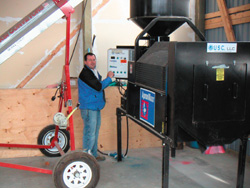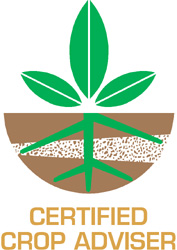
Features
Inoculants
Seed & Chemical
More nitrogen plus fewer aphids
As farmers who grow legumes like soybeans and peas know, rhizobia bacteria form nodules on legume roots to create a win-win relationship. The rhizobia take nitrogen from the air and ‘fix’ it into forms the plants can use.
September 28, 2009 By Carolyn King

|
|
| Aphids are one of the biggest pest concerns for soybean crops. Photos courtesy of Dr. Jennifer Dean, Penn State University. |
As farmers who grow legumes like soybeans and peas know, rhizobia bacteria form nodules on legume roots to create a win-win relationship. The rhizobia take nitrogen from the air and ‘fix’ it into forms the plants can use. In return, the plants provide the rhizobia with a protected growing environment and nutrients. But could rhizobia perhaps benefit the plants in other ways, like helping them fight insect pests?
Some Pennsylvania State University researchers set out to investigate this question. Their study has produced fascinating results that could eventually open up new possibilities for sustainable pest management. “A lot of research has been done on other micro-organisms that are good for the plant, like mycorrhizal fungi, and such that increase the plant’s resistance against herbivores. But very few studies have looked at the effects of nitrogen-fixing bacteria on interactions between plants and insects that feed on them. We wanted to see if there are extra effects of these well-known, beneficial bacteria for the plant,” explains Dr.
Jennifer Dean.
Dean worked with Dr. Consuelo De Moraes and Dr. Mark Mescher on the study. All three are entomologists with an interest in how different organisms interact with each other to affect plant responses. The study was funded by the National Science Foundation, David and Lucile Packard Foundation, Beckman Foundation and the Dupont Young Investigator Award.

|
|
| Rhizobia bacteria form nodules on soybean roots for a win-win relationship with the plant The red colour of the opened nodule indicates healthy rhizobia. | |
 |
|
| Although the study’s results are encouraging, the industry is a long way from a soybean inoculant that is aphid-resistant.
|
According to Dean, previous research has shown that different rhizobia strains can affect plant growth and chemistry in different ways. These strain-specific effects have the potential to, in turn, affect the plant’s interactions with herbivores; the Penn State study was the first one to address this aspect.
The researchers designed their study to compare the effects of different rhizobia strains on soybean aphid, a major soybean pest. At a site in Pennsylvania, they set up three treatments: soybeans treated with a commercial rhizobia inoculant; soybeans associating with naturally occurring rhizobia strains living in the soil; and soybeans with nitrogen fertilizer (nitrogen fertilization suppresses nodulation, so this was a non-rhizobia treatment).
Naturally occurring soybean rhizobia?
The relationship between a legume and rhizobia is very specific; a particular rhizobia species is able to inoculate only certain legume species. Soybeans are not native to North America, and neither are their rhizobia. So how can soybean rhizobia be naturally occurring or “indigenous”?
When soybeans are first grown in a field, they must have a commercial inoculant containing the correct type of rhizobia; usually the species is Bradyrhizobium japonicum, originally from Japan. But once a rhizobia species is established in a field, it can remain there for a long time. “Rhizobia can exist free-living in the soil without a host for many, many years. They don’t fix nitrogen in that state, but they have a stable population where they feed on decaying matter in the soil,” says Dean.
“There have been instances of fields that have not been in soybeans for up to 40 years and they still nodulated well,” notes Horst Bohner, soybean specialist with the Ontario Ministry of Agriculture, Food and Rural Affairs (OMAFRA). “It depends a lot on the soil pH; in very acidic soil they don’t survive as well. On a very sandy soil, they don’t survive as well. And organic matter can have something to do with it. Rhizobia are a living organism, and like every living organism they prefer some habitats to others. But once they are established, they can survive for a long time.”
And like other living organisms, rhizobia in the soil can change and evolve. They can exchange genes with other soil bacteria and they may evolve various traits in response to environmental conditions in the field. So they can develop into site-specific strains of the rhizobia species.
The naturally occurring strains at the study’s site in Pennsylvania had been introduced into the field through inoculation of soybean crops many years before; the site had not been planted to soybean for at least 16 years. Analysis of the genetic makeup of bacteria from plants of each treatment showed the soybean-associating rhizobia in both the commercially inoculated plots and the naturally inoculated plots were Bradyrhizobium japonicum, but they were distinctly different strains.
The researchers monitored aphid populations on the soybean plants, as well as nitrogen concentration in the plants, leaf dry weight, nodulation intensity and seed production. Although the results for the plots with the naturally occurring and commercial rhizobia were similar in many ways, there was a key difference: the soybeans with the naturally occurring rhizobia strains had fewer aphids. “The study shows that the rhizobia-plant interactions, besides the well-known production of nitrogen, are also influencing the plant’s resistance to insect herbivores and that this resistance can vary with the rhizobia strain,” says De Moraes.
The researchers are now trying to discover the mechanism causing the effect on aphids. Dean says one possibility is that the rhizobia strain may influence the plant’s amino acid composition, because amino acids are important for aphid nutrition. Another possibility is that the rhizobia strain may alter the plant’s chemistry in a way that affects the plant’s defence mechanisms against aphids.
Dean emphasizes that their research into this topic is really just beginning, “but it opens up the possibility that we could develop rhizobial inoculants that might specifically enhance resistance for, say, soybean aphids and then maybe other soybean pests in other parts of the country. It gives us another tool to consider when we’re thinking about pest management options.”
As well, De Moraes says researchers at the Penn State lab will be exploring other related topics like the effects of other legume-rhizobia systems on insect pests and how legume-rhizobia systems might influence crop diseases and pathogens. She notes, “A lot of the companies that are producing rhizobia inoculants are often selecting just for nitrogen production, but this research opens up the idea of not only looking for the level of nitrogen production but also looking for the types of resistance to disease and insect pests the plant can produce.”
The bottom line, for now
Although the study’s results are intriguing, Bohner points out that the industry is a long way from having a commercial rhizobia inoculant that fights aphids. “There is no question that aphids are one of our biggest concerns in terms of soybean pests, and any new or different approach to controlling aphids is certainly worth investigating. And the Penn State research is certainly interesting and novel,” Bohner says, “but the question is, in my mind, would it be enough of a difference to be really measurable in the field?”
He outlines several factors affecting how aphids impact a soybean crop that could blur the effects of an aphid-fighting inoculant at a commercial scale. “For instance, we know that some soybean varieties are much more susceptible to being impacted by aphids than others. So we have a lot of genetic variation. Some new aphid-resistant soybean varieties are available already.” Another issue is that aphids cause more grief than usual when it is dry. And when it is dry, the whole nitrogen fixation process slows down. “Another thing to consider is in fields that have had soybeans before, only about 10 to 30 percent of the nodules on a plant will be from the inoculant applied that year. The rest of the nodules will be from the indigenous rhizobia population that has already been established. So just because you’re putting on an inoculant does not mean you will actually get nodules from that inoculant in that field to a big extent.”
Bohner explains, “Once a strain or strains of rhizobia are established, you cannot replace those strains with another strain. You can add some for a single year by inoculating with a new strain of rhizobia, but you can’t remove the old strains. The old ones are already established so they are always able to out-compete the new ones.”
He adds, “If someone could figure out a way of getting rid of the old strains in the ground, replacing them with new ones, that would be a pretty big step forward. But so far no one has been able to figure that out.”
So a soybean grower could be lucky and have naturally occurring rhizobia that are better than commercial inoculants in one or more ways. Or unlucky, like growers in some parts of China where the fields have very old rhizobia strains that are so inefficient in nitrogen fixation that growers have to apply nitrogen fertilizer.
The key is for growers to do small trials on their own fields to compare soybean performance with and without an inoculant. Bohner is a strong advocate of field testing inoculants. “Every year we have somewhere between 10 and 20 trials where we or the farmers do strips to see if there’s a yield benefit to inoculants. Trying them is pretty much the only way to figure out if there’s a benefit.”
And there often is a benefit to inoculating. Bohner says, “On average over the last couple of years we’ve shown about a one bushel per acre statistical yield response to an inoculant in a field that has had lots of beans before.” And there might be greater benefits in the future. “There is a whole raft of new inoculants coming on that could have higher yield benefits for growers.”
Tips for managing soybean aphid
Like soybeans and soybean rhizobia, the soybean aphid is not native to Canada. Originally from Asia, it is thought to have arrived in North America in the mid-1990s, and has been known in Ontario since in 2001. It is now a serious soybean pest here.
For a grower that is not fortunate enough to have an aphid-fighting rhizobia strain in his or her soybean fields, there are a number of steps for managing aphid infestations. OMAFRA recommends the following:
- Scout soybean fields every seven to 10 days from mid to late June until early September;
- Scout fields every three to four days if the aphids reach the threshold of 250 aphids per plant;
- Be ready to take action if the aphid population is actively increasing above 250 aphids per plant on 80 percent of the plants in the field, and the crop is in the R1 (first bloom) to R5 (beginning seed) stages. Spraying at or below the 250 aphids per plant threshold will not guarantee an economic return and can harm beneficial insects that are important for controlling aphids. Spraying in the R6 stage may not be economic.
- Spray the field once it is confirmed that the aphid population is definitely increasing beyond 250 aphids per plant. Use a medium spray quality to get adequate plant coverage.
For more information on aphid control, go to the OMAFRA website (www.omafra.gov.on.ca) or the Ontario Soybean Growers website (www.soybean.on.ca).